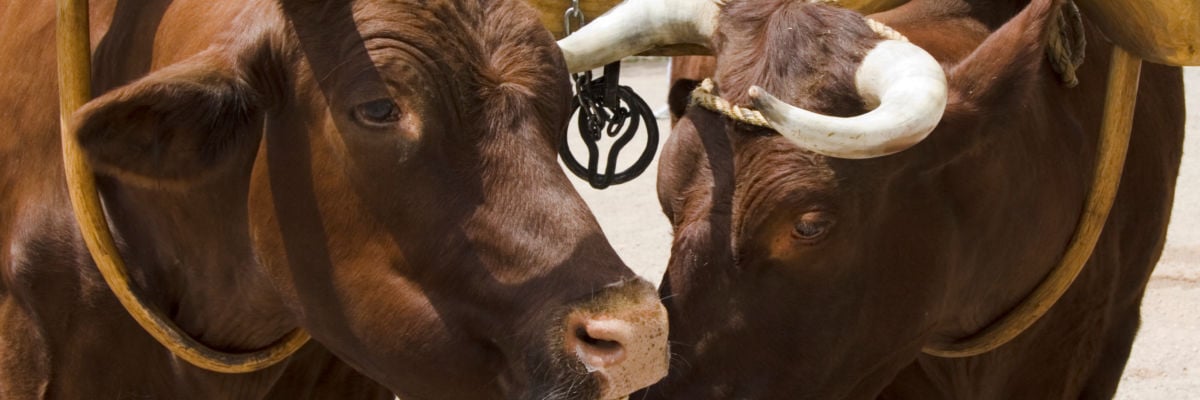
We think of Scandinavia as a region of prosperity. One hundred fifty years ago, it wasn’t. There’s a reason so many Swedes and Norwegians live in Minnesota and the Dakotas.
The Ox is set in 1867 Sweden, amid a famine following poor harvests. Helge and Elfrida Roos are tenant farmers, working for Svenning Gustavsson. They have a two-month-old daughter, Anna.
The film opens just before Christmas. Anna is crying from hunger. Helge is sitting at his farmhouse window, looking at the farm owner’s two oxen. He then rushes out the front door, hesitates for a moment, then brings a sledgehammer down on an ox’s head. He slits its carotid artery, carves it up, then hides the carcass.
Elfrida protests. She wants Helge to tell Svenning. They go to Christmas services, then Christmas dinner at Svenning’s. But they say nothing, even after Svenning’s wife notices the missing ox, and all the men—Helge included—go in search of the beast.
Although Elfrida is far more bothered by the theft and killing, she keeps the secret. Her subsequent behavior, and Helge’s, shows how tough the sin is to swallow. Eventually, some of the meat goes rancid, so Helge disposes of it. All that’s left is the hide, which Helge decides to sell at the county market. Even though he takes off-the-beaten paths to avoid notice of his plans, his pastor runs into him, and Helge finally shows him the hide. The pastor says Helge has to “settle this,” so, accompanied by the cleric, he turns himself in at the market town.
Despite expectations, the judge throws the book at Helge: 40 lashes with birch twigs and life imprisonment. The pastor insists he’ll “help” Helge as he’s carted off to prison.
Helge eventually serves about five years in prison, their brutality visually documented. The pastor’s petition for clemency remains ineffective until Svenning Gustavsson, the aggrieved, signs it, and he’s the last holdout. Finally, the court admits that Helge’s “sentence was somewhat too severe” and releases him.
Elfrida and Anna are reduced to penury, rummaging through garbage and picking wild lingonberries before IKEA made them chic. A chance encounter with a well-provisioned rail worker leads to her becoming pregnant, about which the pastor never tells Helge.
Helge’s return from prison is unannounced. When he gets home, he and Elfrida fall into each other arms. Anna then peers around the door . . . and so does a little boy.
Exploding in anger, Helge leaves the house and tells the pastor he plans on immigrating to America. The pastor is calm but blunt: “It’s easy to condemn people. You should know. You did what you did to save Anna. So did Elfrida. . . . And now you’ve got a son. He can’t help that he was born. And he needs a father. . . . Now it’s your turn to forgive.” Though his trust in the pastor is hurt, Helge returns home, his embrace of Elfrida reflected in the window through which Anna and her brother watch them. The film ends with the observation: “Helge and Elfrida had eight children. All behaved very well.”
Catholic theology affirms the right to private property. It also affirms the universal destination of human goods, so that claims of private property do not pre-empt addressing what human beings need to survive. The latter truth means that, in true need, to take is not necessarily to steal.
The Ox shows, however, that that principle is not as easy as it might look. Helge’s taking threatened everybody. True, Helge’s initial justification of his deed is that Svenning “has got one more.” But everybody sitting around Svenning’s Christmas table ate humbly. True, Svenning tells Helge he can’t give him extra work because he can’t afford it, and Svenning’s lack of the second ox endangered his ability to transport lumber to the mill. That, in turn, could have deprived him of mid-winter income vital to purchase what he and those around him (including Helge and Elfrida) might have needed to survive.
Stealing is what lands Helge in jail, but the perspective of The Ox is broader. The film visually documents the psychology and processes of all sin: evasion, half-truths, guilt, shame, hiding, and finally admission and reparation. These are not Christian constructs: it’s clear that all wrongdoing follows certain courses. There’s a logic to evil, physical and moral. A medical doctor knows how cancer will likely develop. A spiritual doctor knows how sin will likely develop, too.
The Ox is a very biblical film, though not explicitly. The coveting of the “golden calf” (or ox roasted golden brown), the couple eating the forbidden food, their mutual awareness of sin and cooperation in it, even as its mortal effects spin out of control in both their lives, their realization of their deplorable state in a famine-struck country (cf. Luke 15:14)—all these biblical allusions are played out in the visuals and the script.
One might look at the film and draw relativistic conclusions: everybody did what he had to survive. The Ox arguably does not endorse that take. It recognizes that moral absolutes exist for a reason, their relevance even more rather than less necessary in extreme circumstances. Even Helge admits in a prison letter to Elfrida, “Only now do I realize what a terrible thing I did to Svenning.” There are reasons Nykvist filmed The Ox in black and white.
At the same time, the film warns against quick attribution of subjective responsibility to objective situations. The film does not approve of what Helge did, nor of Elfrida’s Esau-like trade of her dignity for bread and a sausage. It does not approve, but it recognizes the fact. And without approving, it recognizes that sin is like what is unleashed from Pandora’s box. It can’t be taken back, but it can be acknowledged and forgiveness for it sought. That is very different from the assumption of the moral relativist, who won’t admit his sinfully presumptuous conviction that “of course, God doesn’t think it was really wrong!”
It’s interesting that when Helge confesses what he did, the first reaction of the Lutheran pastor—an employee of the Swedish state church—is to take Helge to a civil court, not directly address his moral status. And while the initial judgment seems harsh—even a fellow prisoner guffaws that “he got life for killing an ox”—one must remember the threat Helge’s unilateral act posed to everyone. From the perspective of five-year quarterbacking, the sentence was “somewhat too severe.” But perhaps it also reminds us that sin is measured not just by what the sinner does, but also, ultimately, against the Absolute who is sinned against. Holiness and sin are absolutely mutually exclusive.
The Bicycle Thieves, another film about theft, shows us how sin can affect an innocent man. The Ox, an extraordinarily rich film, shows us what sin does to the sinner—the guilty man—and especially to those around him. Where people who should be bound by love are not or cannot be because of sin, a slow dying ensues. Still, Helge and Elfrida recognize and spit out the poison.



